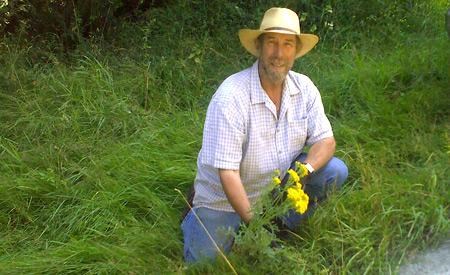A highly noxious invasive plant species is spreading over areas of Texada Island at a rapid rate.
Powell River Regional District Electoral Area D Director Dave Murphy presented the problem to the regional district board, stating he has been taking the problem on to control the insidious spread of the annoying weed.
Tansy ragwort emerged as a threat to the Pacific Coast in the mid 1850s, making its way from California after being introduced to North America. It made its first appearance on Texada along the gas pipeline corridor, on the south end of Texada. “We assume, though it’s not proven, that it probably came in with Terasen [Gas] machinery when the pipeline was built,” Murphy said. “Every year after there were a few more plants. Now there’s a sea of the stuff down at that end of the island.”
According to Murphy’s research, this biennial weed is native to Europe, Asia and Siberia, and normally thrives in cool, wet coastal habitats. It is considered to be a noxious weed by many authorities, because it can dominate pastures, compete with beneficial vegetation, and poison livestock with harmful alkaloids. The alkaloids are contained within the flowers and can cause severe liver damage to horses, deer, cattle and pigs, often leading to death with continued exposure. Tansy ragwort can also reduce butterfat production in cows, and taint honey collected from hives in areas where it grows.
Murphy, also a director with Coastal Invasive Species Committee (CISC), said that part of the challenge is making sure people are aware of the potential harm caused by the plant. “If we act quickly and with diligence we can put a good hold on it.”
He explained that every part of the plant is toxic, including the pollen from its yellow flowers. “It doesn’t affect bees that collect the pollen, however, when they take it back to the hive it contaminates the pollen colony,” he said. “The honey is then contaminated and anyone who eats it will have cumulative liver damage. This problem doesn’t go away and the more you eat the more damage is done.”
He said the plant is in early stages of infestation on the island. “We have an opportunity to get a tag on it, stop it in its tracks,” he said.
He explained that manually pulling it out is only a short-term cure. To really have an impact on its spread, individual plant herbicide would be needed. “This brings its own set of challenges,” Murphy said. “People believe the OCP [official community plan] has language in it that prevents herbicide use. But the language is vague. It was put into the OCP because we wanted to stop large companies—Terasen, ministry of highways, BC Hydro—from indiscriminate large block spraying of herbicides on Texada.”
Ernie Sellentin is project coordinator for CISC and travels up and down the coast working to eradicate all invasive species. “Once the ragwort has taken hold,” Sellentin explained, “the plant maintains a high fecundity. It produces a lot of seed and spreads rapidly...the seeds can blow for great distances on the wind. Quite often it will take to roadsides, and when a grader or mower comes along it spreads the seeds as well, creating a bigger problem.”
Sellentin said the weed is easy to pull, but it’s important to pull them before they go to seed. “If it’s not caught early enough it increases rapidly and forms dense stands,” he said. “It grows to well over a metre tall, especially up by the hydro substation where it originally took. The deer on Texada won’t even browse the tansy, which leaves biological control the only solution to contain it.”
Sellentin said biological control will take care of 80 per cent of the problem, but the remaining 20 per cent is high enough to create more problems down the road.



